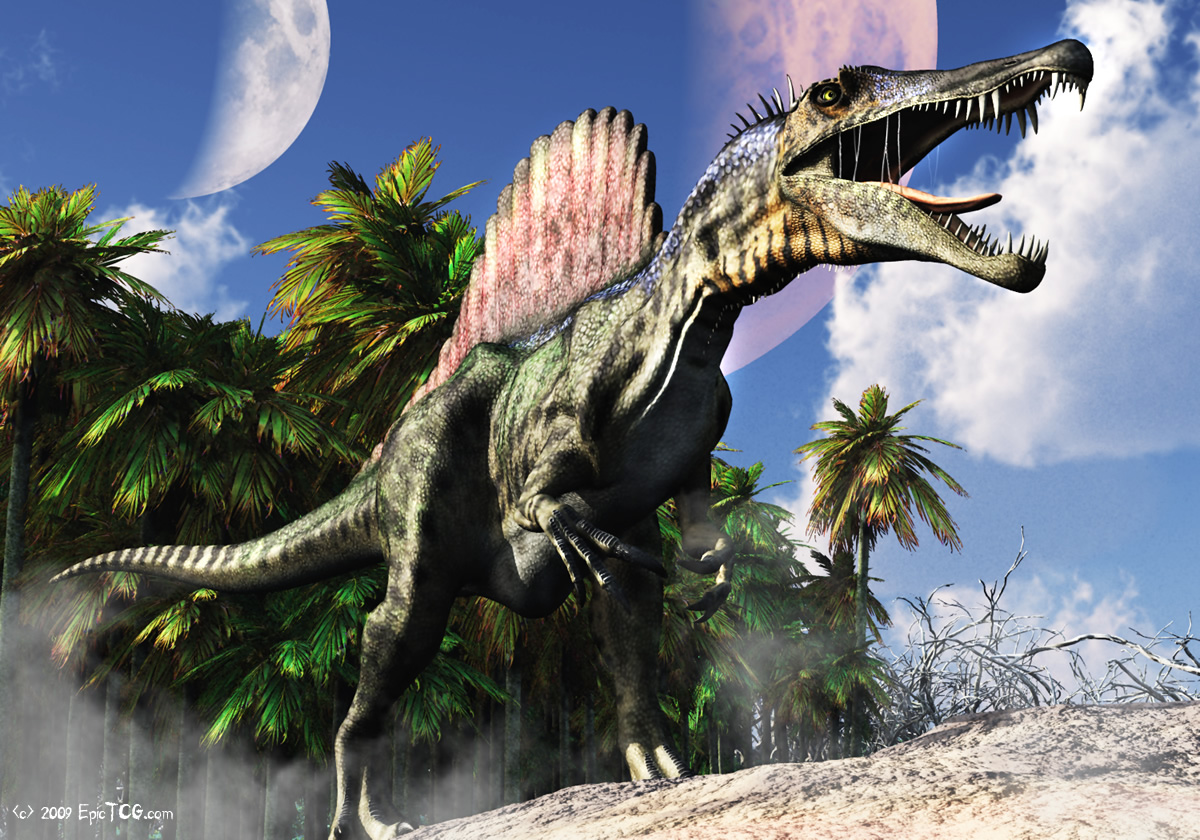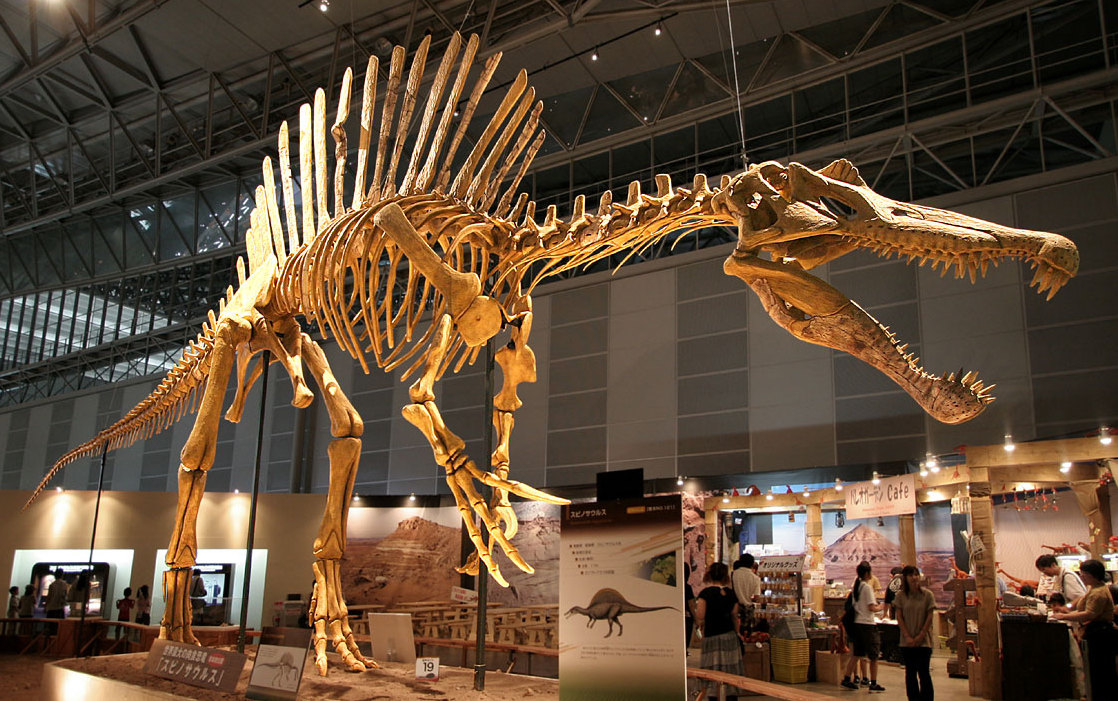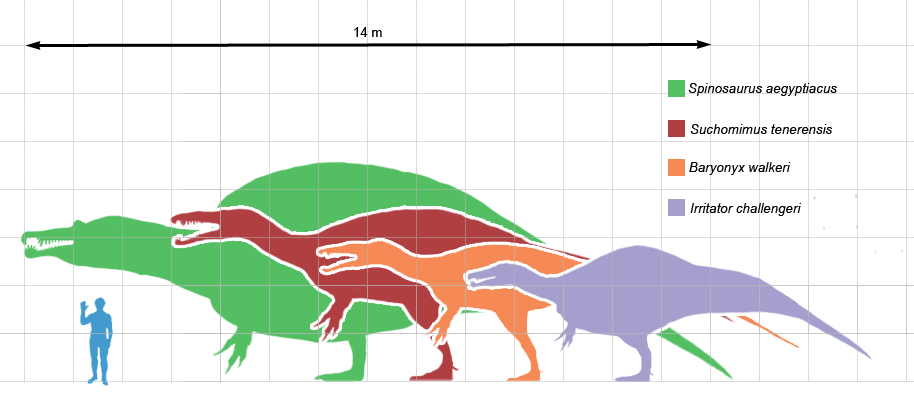Post by Canid Cetus Aves on Dec 6, 2011 18:51:41 GMT -5
Spinosaurus - Spinosaurus Aegypticus

Spinosaurus (meaning "spine lizard") is a genus of theropod dinosaur which lived in what is now North Africa, from the lower Albian to lower Cenomanian stages of the Cretaceous period, about 112 to 97 million years ago. This genus was first known from Egyptian remains discovered in 1912 and described by German paleontologist Ernst Stromer in 1915. The original remains were destroyed in World War II, but additional material has come to light in recent years. It is unclear whether one or two species are represented in the fossils reported in the scientific literature. The best known species is S. aegyptiacus from Egypt, although a potential second species S. maroccanus has been recovered from Morocco. Spinosaurus may be the largest of all known carnivorous dinosaurs, even larger than Tyrannosaurus and Giganotosaurus. Estimates published in 2005 and 2007 suggest that it was 12.6 to 18 metres (41 to 59 ft) in length and 7 to 20.9 tonnes (7.7 to 23.0 short tons) in weight. The skull of Spinosaurus was long and narrow like that of a modern crocodilian. Spinosaurus is thought to have eaten fish; evidence suggests that it lived both on land and in water like a modern crocodilian. The distinctive spines of Spinosaurus, which were long extensions of the vertebrae, grew to at least 1.65 meters (5.4 ft) long and were likely to have had skin connecting them, forming a sail-like structure, although some authors have suggested that the spines were covered in fat and formed a hump. Multiple functions have been put forward for this structure, including thermoregulation and display.

Skull
The skull had a narrow snout filled with straight conical teeth that lacked serrations. There were six or seven teeth on each side of the very front of the upper jaw, in the premaxillae, and another twelve in both maxillae behind them. The second and third teeth on each side were noticeably larger than the rest of the teeth in the premaxilla, creating a space between them and the large teeth in the anterior maxilla; large teeth in the lower jaw faced this space. The very tip of the snout holding those few large anterior teeth was expanded, and a small crest was present in front of the eyes. Using the dimensions of three specimens known as MSNM V4047, UCPC-2, and BSP 1912 VIII 19, and assuming that the postorbital part of the skull of MSNM V4047 had a shape similar to the postorbital part of the skull of Irritator, Dal Sasso et al. (2005) estimated that the skull of Spinosaurus was 1.75 meters (5.7 ft) long. The Dal Sasso et al. skull length estimate was questioned because skull shapes can vary across spinosaurid species.


Size
Since its discovery, Spinosaurus has been a contender for the longest and largest theropod dinosaur. Both Friedrich von Huene in 1926 and Donald F. Glut in 1982 listed it as among the most massive theropods in their surveys, at 15 meters (49 ft) in length and upwards of 6 tons in weight. In 1988, Gregory Paul also listed it as the longest theropod at 15 meters (49 ft), but gave a lower mass estimate of 4 tonnes (4.4 short tons).
Dal Sasso et al. (2005) assumed that Spinosaurus and Suchomimus had the same body proportions in relation to their skull lengths, and thereby calculated that Spinosaurus was 16 to 18 meters (52 to 59 ft) in length and 7 to 9 tonnes (7.7 to 9.9 short tons) in weight. The Dal Sasso et al. estimates were criticized because the skull length estimate was uncertain, and (assuming that body mass increases as the cube of body length) scaling Suchomimus which was 11 meters (36 ft) long and 3.8 tonnes (4.2 short tons) in mass to the range of estimated lengths of Spinosaurus would produce an estimated body mass of 11.7 to 16.7 tonnes (12.9 to 18.4 short tons).
François Therrien and Donald Henderson, in a 2007 paper using scaling based on skull length, challenged previous estimates of the size of Spinosaurus, finding the length too great and the weight too small. Based on estimated skull lengths of 1.5 to 1.75 meters (4.9 to 5.7 ft), their estimates include a body length of 12.6 to 14.3 meters (41 to 47 ft) and a body mass of 12 to 20.9 tonnes (13 to 23.0 short tons). The lower estimates for Spinosaurus would imply that the animal was shorter and lighter than Carcharodontosaurus and Giganotosaurus. The Therrien and Henderson study has been criticized for the choice of theropods used for comparison (e.g., most of the theropods used to set the initial equations were tyrannosaurids and carnosaurs, which have a different build than spinosaurids), and for the assumption that the Spinosaurus skull could be as little as 1.5 meters (4.9 ft) in length. Improvement of the precision of size estimates for Spinosaurus requires the discovery of more complete remains as available for some other dinosaurs, especially the limb bones of Spinosaurus which are "hitherto unknown."


Diet
It is unclear whether Spinosaurus was primarily a terrestrial predator or a piscivore, as indicated by its elongated jaws, conical teeth and raised nostrils. The hypothesis of spinosaurs as specialized fish eaters has been suggested before by A. J. Charig and A. C. Milner for Baryonyx. They base this on the anatomical similarity with crocodilians and the presence of digestive acid-etched fish scales in the rib cage of the type specimen. Large fish are known from the faunas containing other spinosaurids, including the Mawsonia, in the mid-Cretaceous of northern Africa and Brazil. The only direct evidence for spinosaur diet comes from related European and South American taxa. Baryonyx was found with fish scales and bones from juvenile Iguanodon in its stomach, while a tooth embedded in a South American pterosaur bone suggests that spinosaurs occasionally preyed on pterosaurs. Spinosaurus was likely to have been a generalized and opportunistic predator, possibly a Cretaceous equivalent of large grizzly bears, being biased toward fishing, though it undoubtedly scavenged and took many kinds of small or medium-sized prey.
In 2009, Dal Sasso et al. reported the results of X-ray computed tomography of the MSNM V4047 snout. As the foramina on the outside all communicated with a space on the inside of the snout, the authors speculated that Spinosaurus had pressure receptors inside the space that allowed it to hold its snout at the surface of the water to detect swimming prey species without seeing them. A 2010 isotope analysis by Romain Amiot and colleagues found that oxygen isotope ratios of spinosaurid teeth, including teeth of Spinosaurus, indicate semiaquatic lifestyles. Isotope ratios from tooth enamel and from other parts of Spinosaurus (found in Morocco and Tunisia) and of other predators from the same area such as Carcharodontosaurus were compared with isotopic compositions from contemporaneous theropods, turtles, and crocodilians. The study found that Spinosaurus teeth from five of six sampled localities had oxygen isotope ratios closer to those of turtles and crocodilians when compared with other theropod teeth from the same localities. The authors postulated that Spinosaurus switched between terrestrial and aquatic habitats to compete for food with large crocodilians and other large theropods respectively.

Source: Wikipedia

Spinosaurus (meaning "spine lizard") is a genus of theropod dinosaur which lived in what is now North Africa, from the lower Albian to lower Cenomanian stages of the Cretaceous period, about 112 to 97 million years ago. This genus was first known from Egyptian remains discovered in 1912 and described by German paleontologist Ernst Stromer in 1915. The original remains were destroyed in World War II, but additional material has come to light in recent years. It is unclear whether one or two species are represented in the fossils reported in the scientific literature. The best known species is S. aegyptiacus from Egypt, although a potential second species S. maroccanus has been recovered from Morocco. Spinosaurus may be the largest of all known carnivorous dinosaurs, even larger than Tyrannosaurus and Giganotosaurus. Estimates published in 2005 and 2007 suggest that it was 12.6 to 18 metres (41 to 59 ft) in length and 7 to 20.9 tonnes (7.7 to 23.0 short tons) in weight. The skull of Spinosaurus was long and narrow like that of a modern crocodilian. Spinosaurus is thought to have eaten fish; evidence suggests that it lived both on land and in water like a modern crocodilian. The distinctive spines of Spinosaurus, which were long extensions of the vertebrae, grew to at least 1.65 meters (5.4 ft) long and were likely to have had skin connecting them, forming a sail-like structure, although some authors have suggested that the spines were covered in fat and formed a hump. Multiple functions have been put forward for this structure, including thermoregulation and display.

Skull
The skull had a narrow snout filled with straight conical teeth that lacked serrations. There were six or seven teeth on each side of the very front of the upper jaw, in the premaxillae, and another twelve in both maxillae behind them. The second and third teeth on each side were noticeably larger than the rest of the teeth in the premaxilla, creating a space between them and the large teeth in the anterior maxilla; large teeth in the lower jaw faced this space. The very tip of the snout holding those few large anterior teeth was expanded, and a small crest was present in front of the eyes. Using the dimensions of three specimens known as MSNM V4047, UCPC-2, and BSP 1912 VIII 19, and assuming that the postorbital part of the skull of MSNM V4047 had a shape similar to the postorbital part of the skull of Irritator, Dal Sasso et al. (2005) estimated that the skull of Spinosaurus was 1.75 meters (5.7 ft) long. The Dal Sasso et al. skull length estimate was questioned because skull shapes can vary across spinosaurid species.


Size
Since its discovery, Spinosaurus has been a contender for the longest and largest theropod dinosaur. Both Friedrich von Huene in 1926 and Donald F. Glut in 1982 listed it as among the most massive theropods in their surveys, at 15 meters (49 ft) in length and upwards of 6 tons in weight. In 1988, Gregory Paul also listed it as the longest theropod at 15 meters (49 ft), but gave a lower mass estimate of 4 tonnes (4.4 short tons).
Dal Sasso et al. (2005) assumed that Spinosaurus and Suchomimus had the same body proportions in relation to their skull lengths, and thereby calculated that Spinosaurus was 16 to 18 meters (52 to 59 ft) in length and 7 to 9 tonnes (7.7 to 9.9 short tons) in weight. The Dal Sasso et al. estimates were criticized because the skull length estimate was uncertain, and (assuming that body mass increases as the cube of body length) scaling Suchomimus which was 11 meters (36 ft) long and 3.8 tonnes (4.2 short tons) in mass to the range of estimated lengths of Spinosaurus would produce an estimated body mass of 11.7 to 16.7 tonnes (12.9 to 18.4 short tons).
François Therrien and Donald Henderson, in a 2007 paper using scaling based on skull length, challenged previous estimates of the size of Spinosaurus, finding the length too great and the weight too small. Based on estimated skull lengths of 1.5 to 1.75 meters (4.9 to 5.7 ft), their estimates include a body length of 12.6 to 14.3 meters (41 to 47 ft) and a body mass of 12 to 20.9 tonnes (13 to 23.0 short tons). The lower estimates for Spinosaurus would imply that the animal was shorter and lighter than Carcharodontosaurus and Giganotosaurus. The Therrien and Henderson study has been criticized for the choice of theropods used for comparison (e.g., most of the theropods used to set the initial equations were tyrannosaurids and carnosaurs, which have a different build than spinosaurids), and for the assumption that the Spinosaurus skull could be as little as 1.5 meters (4.9 ft) in length. Improvement of the precision of size estimates for Spinosaurus requires the discovery of more complete remains as available for some other dinosaurs, especially the limb bones of Spinosaurus which are "hitherto unknown."


Diet
It is unclear whether Spinosaurus was primarily a terrestrial predator or a piscivore, as indicated by its elongated jaws, conical teeth and raised nostrils. The hypothesis of spinosaurs as specialized fish eaters has been suggested before by A. J. Charig and A. C. Milner for Baryonyx. They base this on the anatomical similarity with crocodilians and the presence of digestive acid-etched fish scales in the rib cage of the type specimen. Large fish are known from the faunas containing other spinosaurids, including the Mawsonia, in the mid-Cretaceous of northern Africa and Brazil. The only direct evidence for spinosaur diet comes from related European and South American taxa. Baryonyx was found with fish scales and bones from juvenile Iguanodon in its stomach, while a tooth embedded in a South American pterosaur bone suggests that spinosaurs occasionally preyed on pterosaurs. Spinosaurus was likely to have been a generalized and opportunistic predator, possibly a Cretaceous equivalent of large grizzly bears, being biased toward fishing, though it undoubtedly scavenged and took many kinds of small or medium-sized prey.
In 2009, Dal Sasso et al. reported the results of X-ray computed tomography of the MSNM V4047 snout. As the foramina on the outside all communicated with a space on the inside of the snout, the authors speculated that Spinosaurus had pressure receptors inside the space that allowed it to hold its snout at the surface of the water to detect swimming prey species without seeing them. A 2010 isotope analysis by Romain Amiot and colleagues found that oxygen isotope ratios of spinosaurid teeth, including teeth of Spinosaurus, indicate semiaquatic lifestyles. Isotope ratios from tooth enamel and from other parts of Spinosaurus (found in Morocco and Tunisia) and of other predators from the same area such as Carcharodontosaurus were compared with isotopic compositions from contemporaneous theropods, turtles, and crocodilians. The study found that Spinosaurus teeth from five of six sampled localities had oxygen isotope ratios closer to those of turtles and crocodilians when compared with other theropod teeth from the same localities. The authors postulated that Spinosaurus switched between terrestrial and aquatic habitats to compete for food with large crocodilians and other large theropods respectively.
Source: Wikipedia







